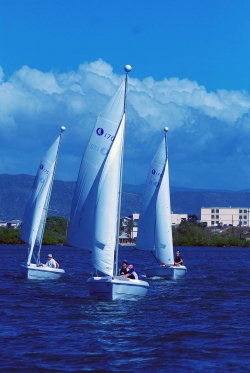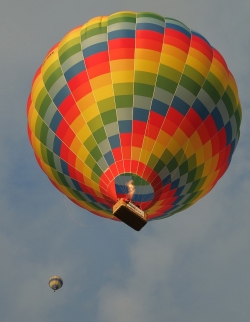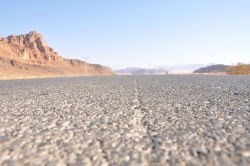Wind is weird. It seems to come out of nowhere, and you cannot even see it. It does nice things sometimes. It flies our kites or sails our boats. Then it does not so nice things, like mess up your hair or blow your homework away. Wouldn't it be nice if you knew just when wind was coming? Then you could choose whether you should go sailing or to a nice restaurant. Wind may be weird, but I think we can figure it out.
Wind is made of air. You know that. You will feel the same stuff you breathe blowing through your hair (or sail) when it's on the move.
Wind is what happens when a bunch of air comes rushing over to replace the air that heat pushed away from the ground. Why is that air all the way up there in the first place? Why is the air down here leaving? And at what point does it decide to all come down?

These guys are always waiting for a windy day.
If you light a match, the smoke will drift up. If you put a fire below a hot air balloon, it will fill up and fly. When things get hot, they get excited. They move away from each other and become lighter, which lets them move up.
Convection is when heat makes things rise. When rocks or cars get hot, they heat the air around them, making the air rise up. When it cools down in the sky, it flows back down toward us. It's a good thing wind is only made of air, or that might really hurt.

Hey, hold on. You forgot your wind jackets!
Pseudopanax at English Wikipedia, Public domain, via Wikimedia Commons
So if it's hot, air moves up. If it's cold, air moves down. Then why doesn't it all rise up and then drop back down on us over and over and over again, like an elevator? First of all, ouch. Second of all, if that's how air worked, then we would be able to breathe, but then we would not be able to breathe, and then we would be able to breathe again, but then not . . . The Earth is made of all kinds of things, but mostly dirt and water. Dirt and rock take in heat and then heat up the air above them. Water reflects heat, hitting it right back into the air. This is why it's usually cooler at the beach than in a desert that's very far from the ocean.
Uneven heating is the idea that dirt and rock take in heat and then heat up the air around them, but water reflects heat back and does not heat the air around it as much. There's hot air rushing off that hot black road, but it's staying pretty cool at the beach. Now think of this happening all over the place, and you'll get the picture.

Wait a minute. This makes wind? How does that work again?
Photo by Jorge Lascar
Heat is not the only thing that changes the wind. It turns out that the way the Earth spins will change its direction too! You cannot see the world turn, but the wind is sure changed by it. Since wind is changed by heat, it should really only move north or south, moving to the warmest places in the middle of the Earth. But because the world is turning at 1,000 miles per hour, the wind seems to bend. The
Coriolis effect explains that the wind changes direction because the world is spinning. Think of it this way. You and a friend are very small and standing on a spinning globe. You try to throw a ball to your friend, but because the globe is spinning, it lands to the right of your friend. Shoot! The same thing happens with wind. Only it does not get mad, because it wasn't trying to hit your friend . . . Or was it?
Wind is weird. It seems to come out of nowhere. It can help or hurt us. But if you know that it will rush from up high where it's cold to down below when it's warm, if you know that it will bend a little because of how the Earth spins, then you might get an idea of where it's going and when. Don't count on it too much though. Even weather people still get their hair messed up.
References:Weather Wiz Kids. "Wind" Wiz Kids, 2010. <
http://www.weatherwizkids.com/weather-wind.htm>
Horton, Jennifer. "Does the
rotation of the Earth affect toilets and baseball games?"
HowStuffWorks.com, 2009.
<
http://science.howstuffworks.com/science-vs-myth/everyday-myths/rotation-earth-toilet-baseball3.htm>
National Geographic Education. "Coriolis effect" National Geographic, 2011. <
http://education.nationalgeographic.com/education/encyclopedia/coriolis-effect/?ar_a=1>